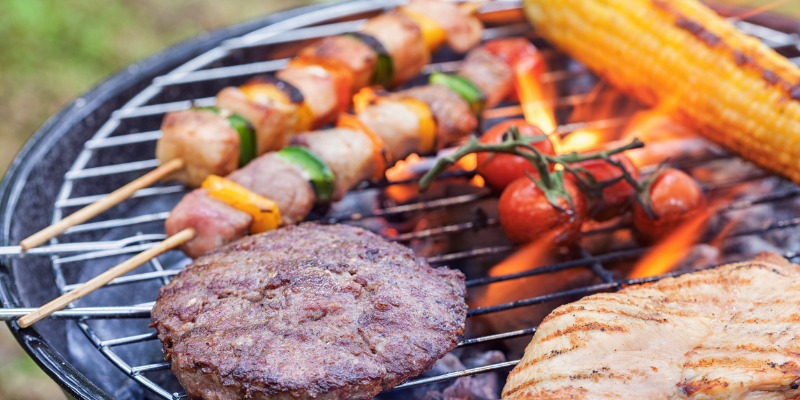
Whether you are a die-hard griller that’s out there all year long, or a grilling chef who believes grilling is best left to the summer months, investing in the right grill will provide the mouthwatering flavours you crave. Here, we offer a complete BBQ buying guide to help you find the best grill for your needs.
What Size Barbecue Do I Need?
Most people find a grill between 400 and 570 square inches works well. However, if you tend to entertain often, you’ll want a larger cooking area of over 600 square inches. Also, the more people you cook for and the more food you cook, the more you’ll need a half or top shelf to keep things warm as you finish each batch.
When is the Best Time to Buy A BBQ?
You’ll find more variety available in March and April, but prices tend to go down as BBQ season is underway. It depends on what is more important to you: finding the exact BBQ you want or paying the best price.
What is the Best BBQ Brand in Canada?
We are partial to Napoleon BBQs because they are made in Canada and offer state-of-the-art features for the ultimate grilling experience. They provide various grills, including gas, charcoal, built-in and portable, and an excellent warranty ranging from 15 years to life. For charcoal BBQs, the Big Green Egg is the iconic kamado-style BBQ with a lifetime warranty and plenty of versatility for the ultimate charcoal grilling experience.
Contact the professional team at Ultimate Home Comfort today to learn more about the best grill for you.
Types of Barbecues: Charcoal versus Propane
This is where the argument begins. There are two schools of thought when it comes to choosing a BBQ:
- Those who would rather microwave a burger than cook it on a gas grill and
- Those who believe charcoal has gone the way of the dinosaurs
We believe it boils down to personal taste. Here’s our unbiased list of pros and cons for each:
Gas
- You have more control over temperature but also don’t get the heat needed for that perfect char.
- You never have to worry about that overly smokey flavour, but you also don’t get the classic charcoal broiled taste.
- They come with a lot more features, but even the low-end models cost much more than a charcoal BBQ and also take hours to assemble.
- There’s less prep time to reach the perfect temperature, but you can’t reach as high a temperature as charcoal.
Charcoal
- You can reach a higher temperature with charcoal to achieve the perfect sear, but that also means you can burn your food without warning.
- Charcoal creates that charcoal-broiled flavour, but some people find it too smoky.
- The charcoal grill tends to be more affordable, but they take longer to reach the ideal temperature, and the cost of charcoal adds up.
- They tend to be way quicker to assemble, but that is often because they come with fewer features and can be difficult to operate.
These pros and cons will help get you thinking about what’s important to you. If you can’t decide, some propane barbecues like the Ambiance 425XT Propane Grill offer the benefits of gas and charcoal, with an optional Charcoal Tray to get that charcoal broiled flavour.
Gas BBQs
Many people consider the gas BBQ to be the ultimate grilling experience. Gas BBQs are ready to start cooking in minutes, offer more control over heat, and can be stoked up using natural gas hookups or refillable propane tanks. Here are the main considerations when choosing gas:
A Tool for Chefs
Some would argue that a gas grill is a tool designed for chefs. You can cook whatever you like on the grill and achieve near perfection without concern about temperature refinement. Whether you are all about burgers, sausages, and hot dogs or delve into everything from a slow-cooked prime rib roast to a nice piece of fish, you’re sure to find the features you need to achieve mouthwatering results.
How Many BTUs are Good for a BBQ?
Gas grills use BTU/hr (British thermal units per hour) to tell you how much it can turn up the heat. For most people, a grill producing between 80 and 100 BTUs per square inch does an excellent job of quick pre-heating and producing a very respectable sear. If you want that perfect sear, look for models offering infrared burners for more intense heat, like the NAPOLEON Phantom Prestige ® 500 RSIB Natural Gas. It features a sear station for this very purpose.
How Much Natural Gas Does a BBQ Use?
A medium-sized grill burns an average of about 1 to 2 pounds of fuel to cook a meal. Natural gas grills cost more but are cheaper to operate than propane grills.
Warranties
Review the various gas grill warranties to find the longest-lasting features, like burners. They tend to require replacement most often and range from two to 10-year warranties. They are easy to replace and aren’t overly expensive, but it’s always nice to know you’re covered should something go wrong sooner than expected.
Construction
Don’t just judge a grill based on its looks. There are a lot of sleek designs out there that can take the focus away from the actual quality of the grill. Lift the lid and make sure it feels heavy and seals well. Turn the knobs and see if they feel sturdy or like they might snap off in your hand. How good are the little details like nuts and bolts? Are they designed to last? Are there models that use welded joints that will last longer than carts put together with bolts? If it has wheels, is it a complete axle, or does it have them bolted to the frame? The sturdier the grill, the safer it is and the longer it will last.
Gas Grill Features
Features impact price, as well as convenience of use. Here are the most common gas grill features to consider:
- Grates: All gas grills come with grates, but not all are created equal. Cast iron grates are considered the cream of the crop for searing and even temperatures, while stainless steel will last much longer.
- Igniters: Gas grills use an igniter to start the fuel source. The best ones tend to be electronic igniters as they are easier to use and last longer than push-button or rotary models.
- Side Burners: Side burners are traditionally used for side dishes or warming barbecue sauce. However, many newer models are catching on to the whole charcoal sear idea and offer special searing burners on the side.
- LED-Lit Controls: If you use your BBQ at night or in the winter when the days are short, BBQs like the Prestige Pro ™ 825 RSBI Propane offer handy LEDs to see what you’re doing. Glowing knobs also let you know whether you’ve left the burners on.
- Fuel Gauge: This is more of a convenience that helps you avoid getting caught with no fuel to fire up those steaks.
- Cleaning Features: Many barbecues, such as Napoleon, offer stainless steel sear plates to collect and vapourize drippings for fewer flare-ups and easier cleaning.
- Gas Barbecue Grill Types: You can choose between natural gas and propane. Natural gas is more affordable to run and never requires a tank replacement, but it does require an expensive gas hookup to your home. Propane is more expensive to run, does not require an expensive gas line hookup, but does require constant tank refills.
Charcoal Grills
Charcoal grills offer a more “authentic” barbecue experience, ideal for die-hard grillers who are all about the fire. They may require more time to heat up and more attention when cooking, but if you love that smokey charbroiled flavour, it’s the only way to cook. Here are the main considerations when choosing a charcoal BBQ:
Airflow Control
When it comes to how to use a charcoal BBQ, airflow regulates the heat of a charcoal grill. More oxygen heats the charcoal, while less keeps the heat lower. A tight lid with an adjustable vent allows you to control airflow, while a bottom vent lets oxygen in to fan the flames.
Coal Bed Access
If you tend to cook over longer periods, such as your famous low and slow ribs, you’ll need a coal bed to add more charcoal easily. Hinged grates or a coal door make it easier to add coals with less disturbance to your meal.
Shape and Size
Wide models like barrel charcoal BBQs have more grill space but a shallower coal pit, making them best for quick cooking, like burgers or sausages. Kettle and Kamado grills have a deeper coal pit for more coal, making them better for low and slow cooking.
Height
Choose a charcoal grill with sturdy legs at a reasonable height for a safer, more comfortable grilling experience.
Charcoal Grill Features
Features are essential for charcoal grills; the more control you have over the heat and flame, the better the results. Here are some important grill features:
- Adjustable Grates & Coal Beds: Adjustable grates and coal beds allow more control over direct heat, reducing the risk of burned outsides and raw insides.
- Ease of Cleaning: Look for grills with ash baskets or drawers that make it easy to clear out ash. Cleaning your charcoal pit is key to a long-lasting charcoal grill. Ash left in the pit/bed is very alkaline, which means it will slowly corrode the steel. It also increases the risk of fires as the ash absorbs food drippings creating the perfect storm for major flare-ups.
What Charcoal is Best for BBQ?
There are two types of charcoal:
- Charcoal briquettes are uniform coals that are slow-burning, ideal for larger pieces of meat or longer cook times. The main problem with briquettes is that they contain fillers that some people feel are not as healthy or flavourful.
- Hardwood lump charcoal is all-natural coal that produces a pleasant, smokey taste. You can experiment with different wood types to find the best flavour, whether it’s applewood, pecan, or mesquite. Lump charcoal is best for quick-cooking foods.
To get the best of both worlds, you can combine the two for longer-lasting coals and a smokey flavour.
Which is the Best BBQ?
So, which is the best BBQ for you? The only way to find the right BBQ for your needs is to speak to an expert to help you make the best choice. At Ultimate Home Comfort, our team of BBQ experts are your BBQ-buying guides, ready to answer all your questions and help you enjoy the best grilling experience possible. Visit our shop today or click here for more information.
Updated 2024
